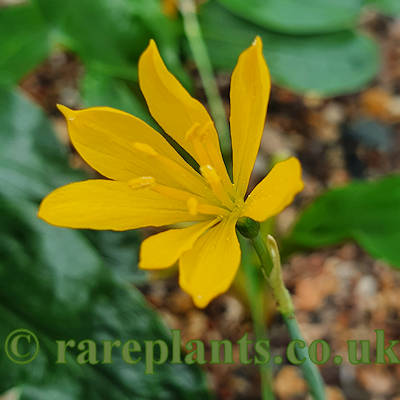Description
(syn. Amaryllis exigua, Braxireon humile, Carregnoa humilis, C. lutea, Gymnoterpe humile, Lapiedra gracilis, Narcissus humilis, Oporanthus exiguus, Pancratium humile, Sternbergia exigua, Tapeinaegle humilis, Tapeinanthus humilis)
This is a rare, very dwarf autumn-flowering species once known (mainly) as Tapeinanthus humilis, with a host of other synonyms. Taxonomists rechristened it to Narcissus humilis before an earlier name was dredged up and it became Narcissus cavanillesii. This simplified version of its naming history ignores the myriad of invalid earlier generic and species names.
It is considered to be a primitive, autumn-flowering Narcissus, which has nothing other than the merest trace of a corona (the trumpet) and which has its petals fused at the base into a short tube. It is native to Southern Spain and North Africa only. The bulbs offered here are traceable to North Africa.
It flowers as soon as growth begins. This can be from September onward to October and even early November. The flowers are quoted as 10-25mm in diameter though I have never seen one larger than 15mm and many are just 10mm. They are a stunning, very bright mid-yellow. The trumpet is vestigial (virtually absent) and hard to see unless you know just where to look and just what to look for.
Bulbs of flowering size are tiny, I repeat The Bulbs Are Tiny, please expect something less than the size of a pea. The tiny bulbs usually make only one leaf, though multi-nosed bulbs masquerading as single bulbs can make more. The leaves are very narrow and sometimes, usually when making a flower, the plant will make no leaves at all, relying on the flower stem for photosynthesis, a phenomenon shared with both Narcissus serotinus and N. viridiflorus which are similarly primitive with only vestigial trumpets and an autumn-flowering habit. N. cavanillesii hybridises in the wild with both of these species (and with others) to yield some really lovely offspring, but the yellow parent itself has a charm and delicacy which I adore.
With a height of only about 8-12 cm (with us) this is ideal for pot cultivation under cold or alpine glass and the bulbs can be packed into a small pot. This is a charming little daffodil steeped in evolutionary significance. It likes a really well-drained, loam soil, which is very dry in summer. It should be noted, that unless you get the conditions right, this will be shy-flowering. Yearly flowering isn’t something to be expected unless you are skilled or a bit lucky. It is however easier to grow and flower than some of the other autumnal Narcissus species. The trick seems to lie in giving the plant quite a severe summer rest and leaving it undisturbed in its compost if possible. We then flood with dilute fertiliser, once, in August and leave it, until resuming normal watering (with further feeding) in September.
We used to grow and offer only Spanish plants, in two different stocks both with provenance and both of these remained very dwarf. These we do not find difficult, once you acknowledge the rather extreme needs of the species. In contrast some Moroccan plants have been said to be easier to grow, more vigorous and larger in growth and flower. This is something that I was initially sceptical of, but it has in fact been the case here. Our Moroccan stock is not that substantially larger in growth, however the leaves are thicker and they are slightly larger-flowered. They do not seem to be any more difficult (or more easy) than Spanish plants. One difference I do find however is that they flower 2-3 weeks later than our plants of Spanish origins, under the same cultural regime.
Raised from JJA.699.951. This plant has been long held by Mike Salmon to be distinct. The subspecies name seems to bear this out. I have also seen unconfirmed mentions of this being genetically distinct from the Spanish plants.





